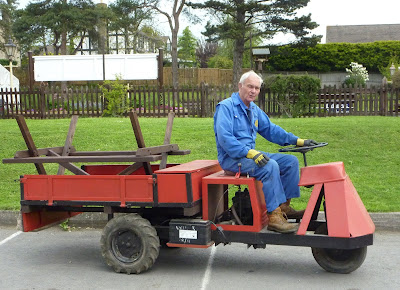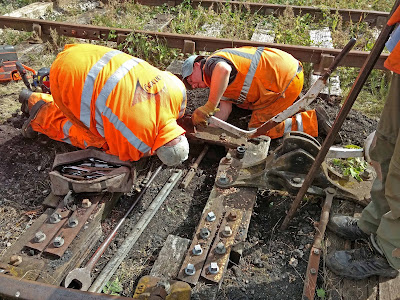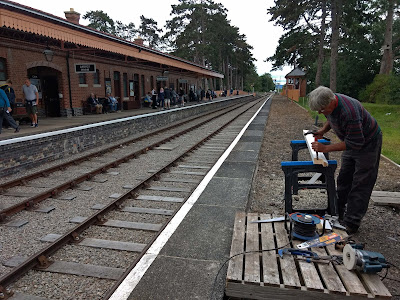It was a bad weather forecast, with heavy rain and thunderstorms predicted, but what are you going to do? We can't just stop. We did sit for a while inside our newly repainted mess coach, it has finally been moved back to its old position, with access and power. We sat in there, and celebrated with some doughnuts as the rain rattled on the tin roof. We still don't have a water supply, as previous arrangements involving a buffer tank are no longer satisfactory, so we need plumbing in to a mains pipe somehow. Then we can brew tea again.
Our job for Saturday was to place ballast retaining boards by up to 4 bridges in the Far Stanley area, our quietest and prettiest piece of the line. During the doughnut fest in the mess coach we discussed how to build these, and we decided to use old concrete military sleepers, which are of no use to us, and which are clogging up the yard anyway. The military sleepers are slightly lighter than your standard concrete sleeper, but, worry not, they are still very heavy.
We got the Telehandler into the yard, and sorted out some suitable candidates.
After some fiddling, we worked out that two could be loaded on to the white Landie, and still shut the rear flaps. You just needed to push them around a bit, just right.
 |
| Steve, Nick, Dave, Bert Ferrule and Jim chew the cud. |
The back of the Landie made a handy support for the arms, while listening to some of Jim's incredible tales from his life with the MOD. (Jim's on the right)
Loaded up with the tools, we set off for the first bridge, and found that we were not the only people at work on that stretch of the line.
We met the lineside clearance gang just as Foremarke Hall passed by, heading for CRC tender first.
 |
| OK, who wants to start shovelling? |
Our first bridge was for an accommodation track, now rarely used except by people on foot (if the pattern in the weeds could be believed).
Ballast here rolls down the slope, exposing the sleeper ends, and making packing the dip you often get by a bridge more difficult.
We had two sleepers on the back of the Landie, and found that this 'lightweight' version could just about be lifted by 4 people with nips.
 |
| 'When I nod my head, you hit it with the hammer'. |
We also did the other end of the bridge, where we see Bert Ferrule knocking in one of the steel pipes that we had sawn to length. Steve was the courageous volunteer who held the pipe in place, while Bert whacked away from above.
And here's the finished product. One ballast retaining sleeper, with ballast shovelled in behind it. In the background the second sleeper is being eased off the Landie for the other side.
The arrival of Foremarke Hall from CRC was a welcome excuse for a break from shovelling ballast back up the slope.
For lunch we returned back to base, and treated ourselves to a tray full of cups of tea from the Coffeepot.
We extracted two more ex military sleepers from the concrete disposal pile, and took them up to the next bridge. This was the one that crossed the road near Prescott (of the hill climb)
Here too the sleeper ends were exposed, as it had been rolling down the hill along the wing walls. Another candidate for a sleeper built ballast retaining wall then.
This time it was Nick who was brave enough to hold the length of pipe upright, while someone whacked away at the top of it.
We had a specially heavy sledgehammer to whack these pipes in, and it did the job very easily. Steve kept a supervisory eye on the proceedings.
The last pipe was extra long, say 8ft instead of 6ft like the others. We had a gay old time trying to whack that one in, as it was much taller, and some distance away from any high point from which to wield the sledgehammer.
We each had a go from different positions, until yours truly got the measure of it with the slightly lighter keying hammer that we had with us. Once the pipe started to go down the rest was easy.
And here on the left is the third sleeper built wall that we built. Bert Ferrule and Dave are just tidying up the site. We had a fourth sleeper with us, but decided to leave that for the next gang on Wednesday. Once you had the system worked out, placing these sleepers wasn't so difficult, but the initial organisation at the beginning of the day took its time.
We returned to Gotherington Skew bridge, where we had parked our cars. A quick look at the timetable showed that a train was due in 5 minutes or so, and so we were able to take this rather splendid shot of Foremarke Hall accelerating away from the skew bridge, round the bend and on to the Dixton straight.
Monday at Broadway
Still a split activity, with John painting the recently fitted boarding on P1, while Neal and yours truly switched their attentions to the steps on P2.
But first of all we decided to clear up the P1 site of material we do not need in the immediate future. The bulky tower scaffold has gone to Winchcombe where it is needed, and the Broadway gang very kindly put in the last slab around the replica uprights, so that the ground can now be walked over. The rest of our stuff has been concentrated in a corner, with just a piece of fencing over the entrance, as we are still working upstairs.
 |
| The P1 staircase now visible in all its glory. Now to finish the roof! |
Underneath the staircase it is now light and airy.
Now we have a special plea to all users of Broadway: Please respect this area, and resist the temptation to fill it with clutter and handy storage solutions for donations of luggage, spare picnic tables or scratch built cupboards. We've put a lot of effort into building this, so let's keep it beautiful!
 |
| Don't do this, please. |
Look after our heritage footbridge now, don't let it sink to this.
Now, back to the day's work. We had a group of special visitors today, three experts from Sperry whom we have invited to test the rails on our line from end to end with ultrasound test equipment
Two machines were set up in the headshunt at Broadway, starting from where the engine stops for the run round.
It looks a bit like a race, but while the machines advance at walking pace, they have to stop and examine whenever an anomaly is detected. It is planned to do the whole railway over several days, mostly in the evenings outside our normal running times.
Before starting off, the sensors were tested on a joint, here using the gel that improves the contact with the rail. One of the sensors was playing up a bit, but then they set off.
It was hoped to reach Toddington at the end of the day.
Meanwhile....
Back on the footbridge, here on the P2 side, Neal was in his element as he started cutting wood for the framework of the sides. He was back and forth with his tape measure checking on the P1 side now complete, but there was little that is standard on these steps, every panel is sightly different from the next. The bridge now at Broadway is a foot higher than the one at Henley in Arden, and this extra height has been won by increasing the rise and the going of every step until the extra height required for the rebuild is reached at the top.
 |
| Neal sawing away, all day long. |
Yours truly carried on with last week's job, which is drilling the countersinks for the bolts holding the steps down.
Last week we ran into several old screws, which blunted the huge spiral drill that we have. Neal sharpened this at home, and we managed to drill almost all the holes up to the intermediate platform, when it became blunt again. The wood is first class quality, and hard as stone.
 |
| Neal's work site, from above. |
At the end of Monday Neal could be seen fitting the cross braces on to the first section, with the bottom frame member done up to the platform.
Tuesday at Broadway
An operating day again, with lots of visitors, but volunteer numbers were tight. We need more help, in all departments. Come and have a go, please do. It's very enjoyable.
The cafe reported that at one point it was a full house, something they hadn't seen since before Covid struck.
Today John was working on the upper half of the P2 steps, where the treads still need widening. This is done by attaching a strip from an unused tread at the back. We have several spares, as the footbridge when at Henley in Arden had two spans, the second carrying a public footpath across the station.
Neal continued with the framework for the sides, here watched with great interest by the passengers in a train that was about to set off. A visitor from the Caravan site across the road expressed great praise for Neal's carpentry in the P1 steps. And rightly so!
Of course we allowed ourselves the usual mid afternoon break, once there was a quiet period between trains.
Three coffees from the cafe, and three Magnums - a veritable treat. Sadly not all of the coffee made it along the bumpy way over the footbridge and down again to the other side.
In the afternoon one train was hauled by D5081, which rumbled slowly into the station with its characteristic slow chug.
Here it is about to pass under the footbridge, with its new steps.
After a while there was a plaintive 'TOOT' and then the 'Splut' reappeared on the loop while running round.
The evening light gave us some fine shadows for this passing shot.
And here is D5081 ready to depart again with 7 on, just waiting for the 'Off' from the guard.
Our last shot is just for the record, so that you can see where we got to. Yours truly completed drilling all the countersink holes for the tread boltheads to go into, and bolted everything down nice and tight. No more wobbly treads anywhere.
Neal spent most of the day working on the second section, interspersed with help for yours truly when the big drill he was using kept hitting various bits of broken screw still left in the old treads.
Normally, at this stage of the blog, we'd be talking about the Usk project, but on Wednesday we're taking Mrs. Blogger out for a day at the seaside. It's a day trip with Vintage Trains, diesel hauled, from Tyseley to Scarborough. A day spent looking out of the window, and being fed and plied with wine - who could say no? Work will proceed on Wednesday as normal - no one is indispensable - but perhaps we'll receive some pictures to show afterwards?
And there's a bit of news, hot off the press, about the Robel powered hand tampers. A second kind and generous sponsor has come forward with an offer to sponsor the second of the pair of Robels that the PWay gang would so much like to have. This is incredible! We are very grateful indeed, and the second sponsorship has given us the confidence to place a firm order for a pair, which, we learned, actually arrived today.
It is very rewarding to communicate like this with those that follow and support us.
Thanks for watching, and supporting. We'll be back soon.
A strange machine
Almost unknown to most, a strange machine sits in hiding in a shed at Winchcombe. One day the shed door was ajar and peeped inside. There was a strange mechanical contraption that we had never seen before (and we have seen a few strange ones). It had GWR on the front.
 |
| John Earle on the Cotton Sturdy |
From the loco on the front, and its vaguely Art Deco, shape you'd guess its period of manufacture as around the 1930s. But you'd be wrong, it was made in the 1960s! Between 100 and 150 were made in Gloucester by the Cotton Motorcycle company from 1966 to 1975. They were used in factories towing trailers, as garden runabouts, and a few were used by British Midland Airways as aircraft tugs, albeit specially fitted with a heavy weight to improve the adhesion.
All but the aircraft tugs were used as tippers, as can be seen here in the garden behind P2 at Winchcombe. There was no hydraulic tipping mechanism - the flatbed was hinged off the centre of gravity so that, when you pulled a lever, it tipped by itself.
Stay away from that lever, we say!
 |
| Bruce Ward on our Cotton Sturdy, before it was painted in chocolate and cream. |
The Cotton Sturdy was originally powered by a 430cc JAP single cylinder engine, but later examples also featured a Briggs & Stratton unit, which is the case with ours. The steering wheel came from a Morris Commercial, and other bits from British industry were 'borrowed' as the versions required. Reliant, Land Rover and Morris Minor would recognise some of the powertrain pieces borrowed. A motoring correspondent noted that when setting off on it, the first impression was one of - vibration!
Our example was purchased by Steve on the PWay for £60 when no longer required by a sewage works near Cheltenham. It's an ugly duckling, but given the low numbers made, it must be quite rare now.
And the Cotton Sturdy's relationship with the GWR? None - just a bit of fun!

















































































